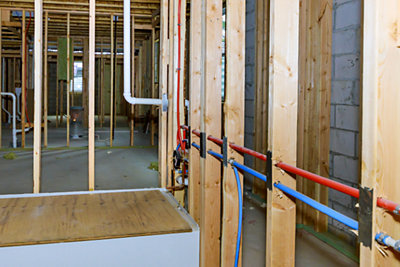PEX Plumbing: The Ups and Downs
Did you know that PEX piping is used in about 60% of new construction projects to date? This makes it a prevalent material used in new buildings. With all its advantages, homeowners want to know where it could fall short and if PEX is a good investment.
PEX has a high tensile strength and is highly durable, cost-effective, and flexible. Yet, it can still experience the concern of pipe cracks or general damage when under the influence of things like significantly intense UV rays. Even with minor downsides, these pipes can still expand and survive high-pressure situations.
There is a lot to know about investing in PEX, so let's talk about the pros and cons of PEX, what makes it a smart choice, and solutions for potential maintenance problems you might face.
Is PEX Plumbing Bad?
The thing is, PEX plumbing isn't bad. Like many situations, problems can feel daunting if you aren't sure how to fix them! All plumbing runs into issues in its lifespan. PEX is a great option, and this article can help you understand it a little more so when problems do arise, you feel prepared to take action.
Like any other material, multiple factors could lead to problems with PEX. Some of these factors could be simple over-chlorination of the water running through it or dezincification, which could weaken and break down the fittings used on the piping.
Another issue could be the piping failing to pass a pressure test. However, remember that PEX is quite common, and with a few minor tweaks over its lifetime, it is still the more affordable option compared to other alternatives.
Let's Think About Longevity
It's important to point out that lifespan should be considered when compared to other common materials. Some homeowners may mention how PVC can last around 100 years, and PEX might last half of that.
PEX often lasts around 50 years. However, PEX is more durable and has more flexibility than PVC and CPVC.
Also, because PEX is made from cross-linked polyethylene, it won't corrode. CVPC, for example, is copper-lined, prone to cracking, and will corrode.
The Durability Is Noticeable
PEX is corrosion-resistant, making it more durable. An option like copper, for example, doesn't have this luxury. PEX also has no sharp edges, which means less chance of damage if the tubing needs to be cut.
PEX also rounds corners easily, almost eliminating the need for cutting. PEX A tubing is the most durable PEX option. This is because it has a significant recovery capability when kinks occur. This means that your plumbing won't be susceptible to leaks like it would with other alternatives.
Noise Reduction
Your water will flow more smoothly through PEX plumbing than with other alternatives. This is what makes it quieter. Its flexibility also plays a part because it's made from plastic versus metal.
With metal piping, you'll get that rattling or clicking sound you might have heard before. With plastic tubing, you won't have this issue. Also, whenever you need to cut the water by shutting off the valve, you won't get a 'bang' from PEX in response to the cut-off like you would with metal.
Simpler to Install
If you're considering different types of plumbing, PEX is an excellent alternative to copper. It's significantly easier to install because it's made of flexible plastic. This material is easy to bend around tight corners, which is one of the primary reasons for its popularity.
You'll have a much easier time with this installation than with a rigid type of plastic or metal piping. Not to mention, PEX is much easier to set up because it requires fewer pipe fittings and connections.
Copper piping, when used for plumbing, stays in good shape over time. Copper pipes, on average, are often expected to last anywhere between 70 to 80 years, if not longer (often up to 100 years).
While copper does last longer, it has its downfalls. It will compete poorly with PEX regarding price or corrosion resistance.
When going with PEX, remember that PEX can often last longer than 50 years, contributing to its popularity. When you realize that at least 35% of homeowners stay in their homes anywhere between 10 to 15 years, this type of plumbing would make an excellent long-term investment. It's important to factor in product longevity for resale value to get more on your investment.
Considering the 'Ups' of This Type of Plumbing
PEX plumbing is both energy-efficient and eco-friendly. It's considered eco-friendly because it takes much fewer resources to produce it. It has a low environmental impact and is immune to corrosion.
Plumbers have also noticed that PEX is temperature-resistant in many cases, and its durability closely matches that of CPVC. If you live in colder climates, using PEX will benefit you.
Every year across the U.S., 250,000 homes suffer damage to their water pipers due to freezing. That damage often results in pipes freezing and breaking. With PEX tubing, it can freeze without actually causing damage to your plumbing. This isn't a reality for other plumbing options.
Professional Services to Combat Potential Hurdles in Your Home
While there are always potential problems with plumbing, PEX is the perfect option for any home.
One of the best ways to be proactive is to work with an experienced plumber who can approach possible issues with preventative solutions. To better safeguard your home and get quality service in minutes versus days on a 24/7 basis, get in touch with the Parker & Son's team today.
Related Reading
Subscribe to our e-Newsletter
Stay up-to-date on current news, promotions, and industry tips.

